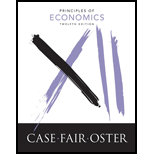
Principles of Economics (12th Edition)
12th Edition
ISBN: 9780134078779
Author: Karl E. Case, Ray C. Fair, Sharon E. Oster
Publisher: PEARSON
expand_more
expand_more
format_list_bulleted
Question
Chapter 7.A, Problem 5P
To determine
Isoquant/isocost diagram and the least cost combination.
Expert Solution & Answer
Want to see the full answer?
Check out a sample textbook solution
Students have asked these similar questions
The Red Racer Company and the Blue Bomber Company are each capable of
minimizing cost and producing 4,000 bicycles per month. Red Racer's factory is
located in an area where the cost of labor is significantly less and the cost of
capital is significantly more than the costs of labor and capital for Blue Bomber.
Assume that each company has access to the same technology to produce
bicycles and draw an isoquant/isocost diagram to illustrate why
the cost-minimizing combinations of inputs for these companies are different.
1.) Using the line drawing tool, draw and label the isocost line for Red Racer's
factory.
2.) Using the point drawing tool, plot and label the equilibrium value for
Red Racer's factory.
3.) Using the line drawing tool, draw and label the isocost line for Blue Bomber's
factory.
4.) Using the point drawing tool, plot and label the equilibrium value for
Blue Bomber's factory.
Note: Carefully follow the instructions above and only draw the required objects.
Units of capital…
For a firm to maximize profit, it must minimize the cost of producing whatever quantity it produces. Use the isocost and isoquant tools to present a firm that is choosing the optimal levels of labor and capital (i.e., tools) to produce a certain quantity and a certain cost. Then, show in your diagram how this firm would respond if it were to expand and spend more on its inputs, assuming it is best for the firm to become more “capital intensive” as it grows. Comment on WHY a firm might best become more capital intensive as it expands, even when the relative prices of labor and capital remain unchanged.
Another farmer purchases nitrate and phosphate fertilizers to produce corn, and the
more of any one input he uses, the lower the marginal productivity of that input. Suppose the
farmer decides to maximize output for a given cost. (That is, imagine a given isocost
line.) Suppose the price of nitrate is 36 cents per pound and the price of phosphate is 24 cents
per pound. Moreover, suppose the farmer currently chooses an input combination such that
the marginal product of a pound of nitrate is 4 bushels of corn and the marginal product of a
pound of phosphate is 3 bushels of corn.
Should the farmer use the current mix of nitrate and phosphate? Should he use more nitrate
and less phosphate? Or, should he use more phosphate and less nitrate? Please carefully draw
a diagram with pounds of nitrate plotted along the horizontal axis and pounds of phosphate
plotted along the vertical axis to support your conclusion. Moreover, please report the slope of
the isocost line. And please report the…
Chapter 7 Solutions
Principles of Economics (12th Edition)
Knowledge Booster
Recommended textbooks for you

 Essentials of Economics (MindTap Course List)EconomicsISBN:9781337091992Author:N. Gregory MankiwPublisher:Cengage Learning
Essentials of Economics (MindTap Course List)EconomicsISBN:9781337091992Author:N. Gregory MankiwPublisher:Cengage Learning Microeconomics: Principles & PolicyEconomicsISBN:9781337794992Author:William J. Baumol, Alan S. Blinder, John L. SolowPublisher:Cengage Learning
Microeconomics: Principles & PolicyEconomicsISBN:9781337794992Author:William J. Baumol, Alan S. Blinder, John L. SolowPublisher:Cengage Learning




Essentials of Economics (MindTap Course List)
Economics
ISBN:9781337091992
Author:N. Gregory Mankiw
Publisher:Cengage Learning

Microeconomics: Principles & Policy
Economics
ISBN:9781337794992
Author:William J. Baumol, Alan S. Blinder, John L. Solow
Publisher:Cengage Learning
